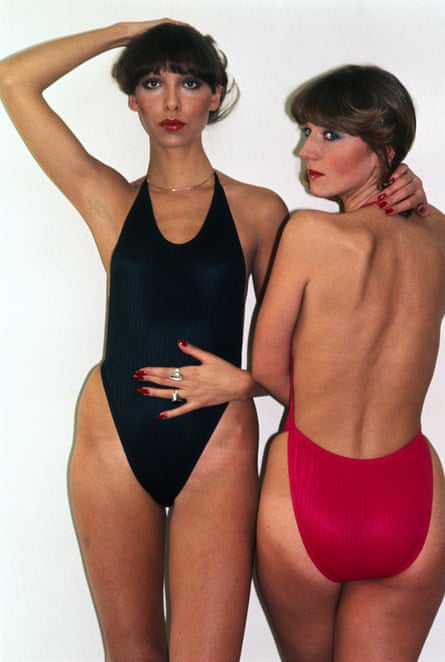Only a few swimsuits have ever made it into the Costume Institute collection of the Metropolitan Museum in New York and the best known is perhaps the least substantial, a super-simple shape sewn from a scarce metre of white nylon fishnet. It has a tactfully lined crotch but the mesh does not conceal breasts and nipples, yet it is not crude or sleazy. On the perfect body, it would be witty.
The perfect body concerned belonged to Cheryl Tiegs, the leading model in 1978, when Monika Tilley was asked to design the garment specially for Sports Illustrated magazine’s annual pin-up fest, its swimsuit issue.
Tilley, who has died aged 86, might have been influenced by the shape of Mary Quant’s revolutionary “body-stocking” lingerie of the 1960s, but the sass of the suit, the way it sexed up all-American healthy exercise, was Tilley’s own. Her idea-sketches were as elemental as cartoons, and cost the pattern-cutters of the swimwear companies she supplied – Cole of California, Elon of California – much effort to translate to manufacture.
Her other famous design, also for Tiegs for Sports Illustrated, in 1983, arrived at Elon’s San Diego factory as a rough drawing, plus some white polycotton fabric and scraps of lace, with a request for an urgent sample within days. Elon made it on time – it resembled the all-in-one “teddy” undergarment 20s flappers had worn beneath short frocks – as an “editorial” promotion, mainly for the publicity, but after Tiegs modelled the “lingerie suit” on the magazine cover, it was a bestseller.

Tall, slender, sporty, hearty Tilley took regular part in the swimming, skiing and tennis for which she designed. She had moved from being a fashion illustrator for Harper’s Bazaar to contracting to come up with ideas for firms that were part of the then huge US garment industry, at first in childrenswear. She then worked for White Stag, doing ski-wear, which had changed since the 1958 invention of Spandex (AKA Lycra or elastane), as just adding a small percentage to a fabric made it stretchable.
When she joined Elon in 1968, mailing designs from her home in New York, garment trade central, to California, where a beachwear industry had grown up, she applied her always updated knowledge of new textiles to swimsuits; she claimed to have been the first to use Spandex for an unconstructed swimsuit which kept its, and its wearer’s, shape without seams, built-in bra or padding. In other sportswear, she experimented with techno-fabrics as soon as they were invented, notably polar fleece from 1979.
Tilley became well-known in the garment business throughout the 70s but used her many New York press contacts to publicise brands that were her clients’ (tags read “By Monika for Elon”) rather than herself. Even after she set up her own company and label, she was uninterested in personal publicity, willing to be the creative force behind a celebrity name: trackwear for the athlete Bruce Jenner (now Caitlyn Jenner) in the 70s, swimwear with the model Christie Brinkley in the 80s.
She was supplying the jeans company Levi Strauss when it sponsored the 1980 and 1984 Olympics, and it asked her to design the US team parade uniforms; in 1984, they marched in cowboy boots, Stetsons and blue jeans, with red cuffs.
Tilley was not born in the US, but like so many NY garment industry workers, was an immigrant, from Vienna. Her father, Franz Nowotny, was a civil servant, and her mother, Margarete (nee Kinatader), a teacher; neither approved of Monika’s decision to take a master’s degree at the Vienna Academy of Fine Arts.

She met Merten Tilley, an American who was studying business in Vienna, and they married in 1957, moving later to Queens, New York, although Monika said her migrant status was uncertain for a time; she could not cash her pay cheques from Harper’s because she did not have a labour permit.
In the 80s, clothes previously only acceptable on track or field, or for dance practice and exercise classes, became the basis for women’s leisure outfits, with stretch fabrics, fleece and synthetic blends for ease and machine-laundering.
Tilley contracted to design what was then called loungewear (to us, under lockdown in 2021, everyday wear) for the Vassarette label, and also developed her own inexpensive line, At Ease. Her nightwear was as fresh as that lacy swimsuit, and her leggings and cuddly pullovers for flopping on the couch have become home staples. But it was the swimsuits that won her two Coty awards.
The American apparel industry began off-shoring its manufacturing in the 80s, but Tilley stayed dedicated to the idea of US fashion, its relevance to real, active, lives, and to the Council of Fashion Designers of America, founded in 1962 to promote it.
She was on its board for decades and in 1996 founded its scholarship programme, liaising with colleges and universities to give a break to students from a wider range of backgrounds.
Her marriage to Merten ended in divorce; their children, Martin and Mona, survive her.

Comments (…)
Sign in or create your Guardian account to join the discussion